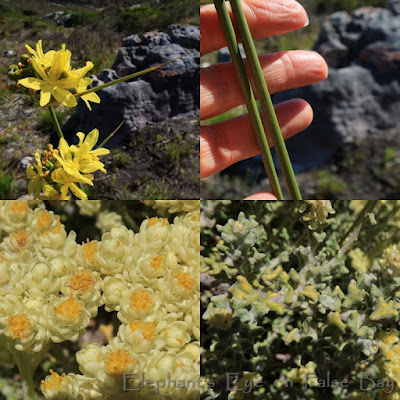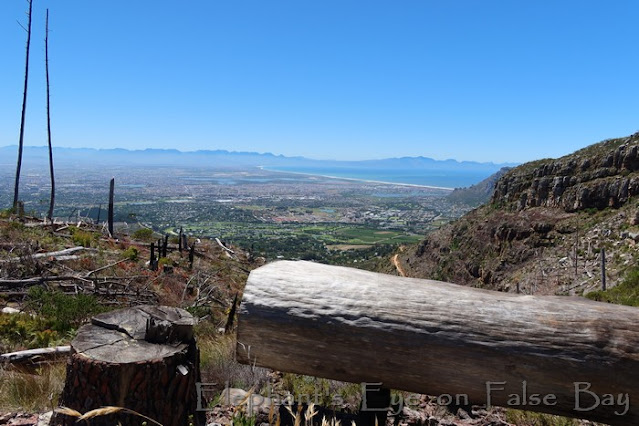December hikes to Jonkersdam and Silvermine
by Diana Studer
- gardening for biodiversity
in Cape Town, South Africa
Hiking among wildflowers
in the mountains
around Cape Town
Off the Glencairn Expressway on the Jonkersdam Trail. I inherited a few Aloe maculata when we moved to False Bay. I didn't realise they are one of our few local fynbos aloes! We had to scramble over rocks and thru cleared aliens. Bloodied but unbowed, we reached our photo target.
 |
| Aloe maculata Jonkersdam in December |
Bobartia indica has round stems. Deceptive plants. Out of bloom without that knot of yellow flowers, it is a rush iris. Helichrysum patulum, little straw flowers in ivory with golden hearts, the leaves help to decide which species am I looking at.
 |
| Bobartia and Helichrysum at Jonkersdam in December |
Both in Campanuloideae bellflower subfamily. Wahlenbergia subulata precisely curled in four directions. Roella amplexicaulis with leaves furled and toothy.
 |
| Campanuloideae at Jonkersdam in December |
At Silvermine we split into two groups and mine turned towards Noordhoek for Disa atricapilla. Usually seen after fire, as we did at Groot Winterhoek in 2009. Erica multumbellifera little cerise cherries. The Disa atricapilla. Roella triflora (not sure where it hides three flowers) Large carpenter bee. Vygie with lilac flower, and leaves spotted and falci = sickle shaped Lampranthus falciformis.
 |
| December flowers at Silvermine with Disa atricapilla |
The next week at Silvermine we hiked towards Elephant's Eye for the Disa tenuifolia we missed. Former pine plantation. Invasive remnants have been felled and left in place for erosion control while the fynbos returns.
 |
| View from Silvermine across the Cape Flats to the Hottentos-Holland mountains and Africa |
We live down in the Chilly South and settled in and along Princess Kasteel stream to cool off for our tea.
 |
| Princess Kasteel stream |
Tachinid bristle fly on Pseudoselago serrata. Sitting on the rock in the stream, I had tiny companions. A Cape Julia skimmer dragonfly at my shoulder. Cape river frog tadpole by my feet. Walking back Melyris groovewing flower beetle on Syncarpha vestita.
 |
| Little lives among the fynbos at Silvermine |
Yet a nother yellow daisy, but with interesting leaves Ursinia dentata. Cream and burgundy Drimia exuviata has very fined thread-like leaves. The yellow Disa tenuifolia we missed on the way out, and looked twice as hard on the way back. Tucked on the shady side of rocks we found 2 plants. Salmon Watsonia tabularis found only on our Cape Peninsula.
 |
| December flowers at Silvermine with Disa tenuifolia |
Our hikes are listed on my page.
I invite you to join us at Elephant's Eye on False Bay. Please subscribe as you prefer
via NEW non-Feedburner at Feedly,
or my Facebook blog page
of Elephant's Eye on False Bay
Teal blue text is my links.
To read comments if you are in a Reader,
first click thru to the blog)
Thanks for comments that add value. Your comment will not appear until I've read it. I welcome comments on posts from the last 2 months.
Google and Blogger comments uncooperative? Use Name / URL instead.

That Disa atricapilla is incredible! It's interesting to see Wahlenbergia in the wild. Years ago, I purchased plants simply labeled as Wahlenbergia species (in a solid lavender-blue color) but I've never seen them anywhere else and the original seller hasn't offered the plants in recent years. They did well here but they seem to be gradually dying out.
ReplyDeletePerhaps yours are annuals? They are often ethereal plants.
Deleteglorious
ReplyDeleteThanks for sharing your hike highlights. Sounds like these were challenging outings! The groupings of plants/blooms you found along the way are fascinating, as always. And the Disa atricapilla is so unique and beautiful!
ReplyDeleteThese blooms make me happy.
ReplyDeleteAmalia
xo